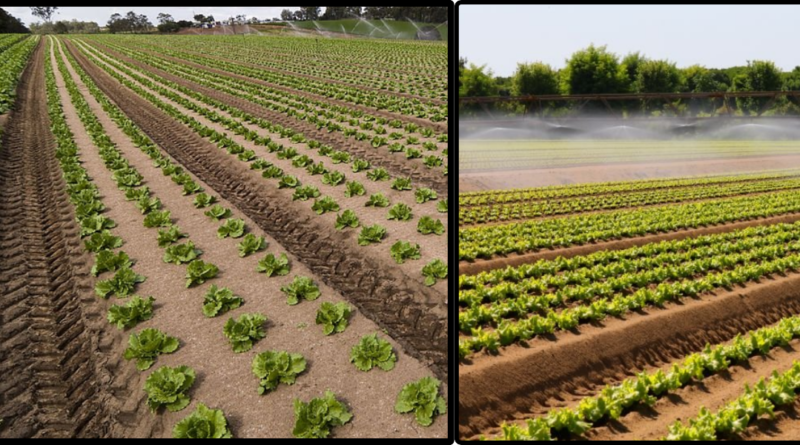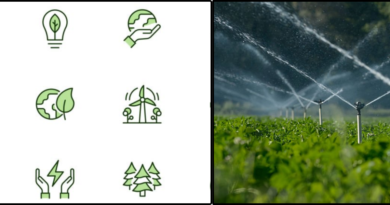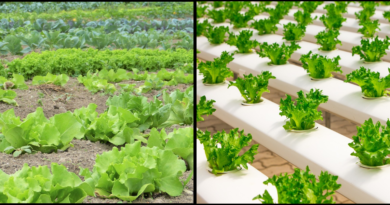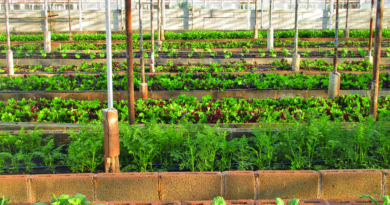Organic Farming vs Conventional Farming
Introduction of Organic Farming vs Conventional Farming
Organic vs. conventional farming techniques have become a key concern for those who wish to make informed food choices as the agricultural landscape continues to change. Philosophical perspectives, economic issues, environmental effects, and other elements are all included in the argument. In order to provide readers with a thorough comparative study to aid in their knowledge, this article seeks to explore the subtle differences between conventional and organic farming.

Principles and Definition:
Crop cultivation by natural processes is the focal point of organic farming, which is a comprehensive strategy. By avoiding artificial fertilizers and pesticides, this approach focuses on boosting soil health, biodiversity, and sustainability in general. Conventional farming, on the other hand, takes a more contemporary approach, using synthetic inputs to enhance yields and serve the demands of an ever-growing population.
Approach and Philosophy:
These farming techniques are based on quite different ideologies. Organic farming is in line with a naturalistic philosophy that sees the farm as an ecosystem that can maintain itself. On the other hand, traditional or conventional farming prioritizes technical efficiency, making use of scientific and mechanical breakthroughs to maximize productivity.
The health of the soil:
Organic farming performs in the area of soil health because of techniques like crop rotation, cover crops, and composting. By increasing microbial activity and organic matter, these techniques promote better soil fertility and structure. On the other hand, conventional farming raises worries about long-term soil damage, even though it temporarily increases yields through the use of synthetic fertilizers.
Utilization of Chemical Sources:
One important area of difference is the utilization of chemical inputs. Synthetic fertilizers and pesticides are prohibited in organic farming, which instead uses natural nutrient management techniques and pest control techniques. In contrast, conventional farming uses a lot of synthetic inputs, which raises concerns about the effects these inputs could have on the environment and human health.
Crop Diversity and Rotation:
Crop rotation is one method used in organic farming to enhance variety and lower the danger of diseases and pests. Monoculturehttp://n.wikipedia.org/wiki/Monoculture, which is frequently connected to conventional farming, might make an area more susceptible to certain pests and so require more chemical treatments.
GMOs, or genetically modified organisms:
Organic farming emphasizes conventional breeding techniques while taking a strong stand against the use of genetically modified organisms (GMOs). Integrating genetically modified organisms (GMOs) is a widespread practice in traditional farming to give features like herbicide or insect resistance. Nonetheless, there is still concern over the lasting impact of GMOs on the environment and human beings.
Water Resources Management:
Sustainable agriculture requires effective water management. Mulching and cover crops are two techniques used in organic farming to reduce irrigation runoff and save water. Conventional agricultural methods may require heavy irrigation techniques with possible environmental implications, regardless of variations in water efficiency.
Economic Factors:
The two farming methods have different economic dynamics. Because organic farming involves labor-intensive methods, it might require larger initial costs, but as the market for organic products grows, pricing may become more competitive. Conventional farming, which is sometimes associated with cheaper launching costs, has difficulties because of market swings and disadvantages brought on by intensive techniques.
Energy Effectiveness:
These methods of farming are also distinguished by perceptions of energy efficiency. Organic farming is frequently thought to be more energy-efficient due to its emphasis on human labor for tasks like weeding and composting. The energy requirements of conventional farming, which depends on machines and artificial inputs, could be greater.
Effect on the Environment:
Soil erosion, conservation of biodiversity, and greenhouse gas emissions are all included in the total environmental effect. Organic farming strives to reduce adverse effects on the environment by emphasizing sustainable techniques. Loss of habitat, water contamination, and soil deterioration can all be consequences of conventional farming, particularly when done widely.
Consumer Well-Being:
When choosing between organic and conventional vegetables, consumer health is a major factor. Customers who are worried about pesticide residues on conventional crops are drawn to organic farming as it avoids the use of synthetic pesticides. Conventional farming maintains an equilibrium between the necessity for efficient production and concerns about food safety, a topic of continuous discussion and study.
Teamwork-Based Solutions:
Agencies, scientists, policymakers, and consumers all have a shared obligation to work together to promote sustainable agriculture. Research collaborations and farmer education programs are two examples of initiatives that foster knowledge-sharing and can help develop and implement sustainable practices. GreenHealings.com may function as a central point for promoting cooperation, reducing interaction, and stimulating idea sharing to advance agriculture toward a more sustainable future.
The Act of Balancing
A balanced strategy is necessary to negotiate the complexities of both conventional and organic farming. Acknowledging the advantages and disadvantages of each approach makes for a more balanced viewpoint than advocating for one as being fundamentally better. Organic farming prioritizes biodiversity and environmental sustainabilitySustainable Agriculture through Robotics and Automation, whereas conventional farming meets the urgent need to produce more food to feed the world’s expanding population. Integrating techniques that maximize ecological health and agricultural efficiency is encouraged by a balanced approach.
Support for Sustainability in Policy:
Government policies are crucial in determining how agriculture develops. It is crucial to advocate for laws that encourage and facilitate sustainable behavior. GreenHealings.com may serve as an arena for promoting legislative reforms that advance fair trade, ecological integrity, and farmer welfare. Policies of this kind can help create a regulatory framework that promotes the use of ecologically and socially conscious farming methods.
Accepting Innovation:
Adopting innovation and advances in technology is a necessary step in the move to sustainable agriculture. The efficiency of agricultural techniques may be improved through the use of data-driven approaches, precision agriculture, and technological advances. GreenHealings.com has the ability to actively participate in new trends and inventions, giving farmers a place to obtain the most recent advancements and incorporate them into their operations.
Balancing Act:
Navigating the intricacies of organic and conventional farming requires a balanced approach. Rather than positioning one method as inherently superior, acknowledging the strengths and weaknesses of each allows for a more nuanced perspective. Organic farming brings environmental sustainability and biodiversity to the forefront, while conventional farming addresses the pressing need for increased food production to feed a growing global population. A balanced approach encourages the integration of practices that optimize both ecological health and agricultural efficiency.
Making informed choices:
As consumers become more conscientious about the origins of their food, the need for informed decision-making becomes crucial. GreenHealings.com plays a pivotal role in empowering individuals to make choices aligned with their values. Transparent communication about farming practices, labeling, and the broader ecological impact of various products enhances consumer awareness. Making informed choices involves considering the environmental, health, and ethical implications of the food we choose to consume.
Looking Toward Sustainability:
The future of agriculture lies in the hands of collaborative efforts aimed at sustainable practices. Organic and conventional farming need not exist in isolation; instead, there is potential for a synergistic approach that incorporates the best of both worlds. Agroecology, an integrative approach that draws from organic and conventional farming practices, is gaining traction. This forward-looking perspective recognizes the need for innovation while upholding the principles of environmental stewardship and sustainability.
Collaborative Solutions:
Sustainable agriculture is a collective responsibility that involves collaboration among farmers, scientists, policymakers, and consumers. Initiatives that promote knowledge-sharing, such as farmer education programs and research partnerships, can contribute to the development and implementation of sustainable practices. GreenHealings.com can serve as a hub for fostering collaboration, facilitating dialogue, and encouraging the exchange of ideas to propel agriculture towards a more sustainable future.
Policy Support for Sustainability:
Government policies play a pivotal role in shaping the direction of agriculture. Advocating for policies that incentivize and support sustainable practices is essential. GreenHealings.com can be a platform for advocating policy changes that promote ecological integrity, fair trade, and the well-being of farmers. Such policies can contribute to a regulatory environment that encourages the adoption of environmentally friendly and socially responsible farming practices.
Embracing Innovation:
The evolution towards sustainable agriculture involves embracing innovation and advancements. Technological innovations, precision agriculture, and the integration of data-driven approaches can enhance the efficiency of farming practices. GreenHealings.com can actively engage with emerging trends and innovations, providing a space for farmers to access the latest developments and implement them in their operations.
Community-Led Initiatives:
Local communities play a vital role in fostering sustainable agricultural practices. Community-supported agriculture, farmers’ markets, and participatory decision-making processes contribute to a sense of shared responsibility. GreenHealings.com can actively engage with local communities, serving as a conduit for information exchange and collaboration. Building strong connections between consumers and local farmers strengthens the foundation for a resilient and sustainable food system.
Conclusion:
The decision between organic and conventional farming is not just a basic one, but rather the result of a nuanced interaction between a number of factors, including priorities, values, and environmental concerns. GreenHealings.com serves as a forum for raising consciousness, stimulating discussion, and building a community around sustainable living.
Making educated decisions that support personal beliefs and further the larger objective of a healthier and greener world is crucial as both consumers and farmers navigate this uncertain environment. Regardless of one’s preference for the technical efficacy of conventional farming or the natural ethos of organic farming, a common commitment to sustainable agriculture is essential to ensuring a future in which the production of food coexists peacefully with environmental preservation.




